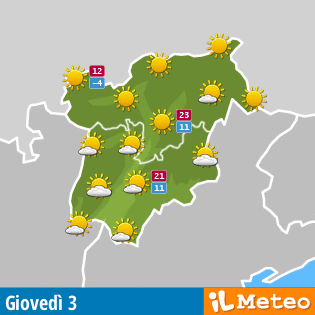The Carnival in Fassa Valley
and Lozzo di Cadore
 |
| Italian |

One of the most important and best preserved carnivals is the Carnival of Fassa Valley. This carnival is characterized by brightly colored masks that convey a strong sense of humor. Amongst the Ladin carnivals it finds more similarities in the carnival of Comelico Superiore. The Carnival involves residents of two small villages in the upper part of the valley: Alba (lad. Delba) and Penia, both surroundings of the town of Canazei.
The masks / faceres of the Fassa carnival traditions are: the “Laché”, the “Bufon” and the “Marascons”, which are the leader masks, surrounded by many other masks (faceres da bel e faceres da burt), which, in part as accures in the Val Comelico, are the positive and negative aspects of life, happiness and difficulties, beauty and ugliness, youth and old age. All macheres / faceres are hand-made by local artists, in wood, usually using pine and painted in oils. The Fassa carnival is not characterized only by the masks, but also by the mascheredes, small theater shows .
In addition to the carnival, there are in the other towns of the valley other typical masks: at Moena the “Arlechins” and the “Lonc” in Campitello, Vigo, Moena and Pozza the “Om by Bosch” and the “Coscrit te Ceston”.
The most important masks (the Bufon and the Laché) are so characterized:
Bufon: big nose and conical hat adorned with ribbons. It approaches the most beautiful girls and embarrassed them with various anecdotes and exposes the vices and virtues of the town and of its inhabitants.
Laché: mask with bright colors, attracts the attention on itself and opens the parade.
Zinghenesta
This carnival festival of the Valley of Biois was almost lost over the years, only to be rediscovered and fortunately redeveloped in recent years. The procession of Zinghenesta is particularly interesting because it unites masks and typical features of other carnivals in the Dolomites (the “Paiazo”, the “Laché” and the “Matiei” which opens the procession), with other unknown figures in the Dolomites (the “Zinghenesta” and the “Gendarmes”). The parade is opened by Paiazo, colorful mask with a prankster character, followed by three Laché and three Matiei. The Zinghenesta is the most important figure of the parade. It is the most beautiful girl of the town wearing a costume with colorful scarves donated by numerous suitors. The girl is accompanied by some Matiei and two Puster who bless the people with the sprinkler and twenty armed Sasin. The tail of the procession sees the gendarmes, a parody of the Austrian gendarmes. The procession then gives rise to a sort of theatral act where the Zinghenesta is courted by some men, the Sasin, taking advantage of the hustle and bustle annoy the viewers and, finally, arrive the gendarmes chasing the Sasin. Surprisingly, the whole is concluded by the arrival of masks dressed up as chimney sweepers which dirty of soot the girls.
The Carnival of Lozzo di Cadore
After a known Carnival as that Fassa Valley, a virtually unknown carnival, but which has been preserved to the present day is the one of Lozzo di Cadore. The main mask is the “Smotazin”, also known as the “Volto de Apo”, named after its inventor, scary-looking wooden mask and with his tongue lolling out of his mouth. Shrove Thursday is the last day of the carnival where the Smotazin jumps and dances tainting the viewers with the “mota” (mud). The Smotazin is led by a knight.
